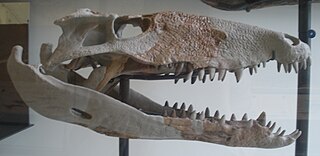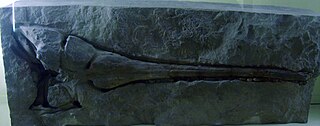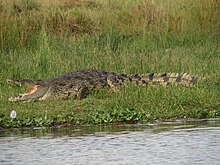
Goniopholis is an extinct genus of goniopholidid crocodyliform that lived in Europe and North America during the Late Jurassic and Early Cretaceous. Like other goniopholidids, it resembled living crocodilians, and probably had a similar ecology as semi-aquatic ambush predators.

Crocodylomorpha is a group of pseudosuchian archosaurs that includes the crocodilians and their extinct relatives. They were the only members of Pseudosuchia to survive the end-Triassic extinction. Extinct crocodylomorphs were considerably more ecologically diverse than modern crocodillians. The earliest and most primitive crocodylomorphs are represented by "sphenosuchians", a paraphyletic assemblage containing small-bodied, slender forms with elongated limbs that walked upright, which represents the ancestral morphology of Crocodylomorpha. These forms persisted until the end of the Jurassic. During the Jurassic, crocodylomorphs morphologically diversified into numerous niches, with the subgroups Neosuchia and the extinct Thalattosuchia adapting to aquatic life, while some terrestrial groups adopted herbivorous and omnivorous lifestyles. Terrestrial crocodylomorphs would continue to co-exist alongside aquatic forms until becoming extinct during the Miocene.
Elosuchus is an extinct genus of neosuchian crocodyliform that lived during the Middle Cretaceous of what is now Africa.

Notosuchia is a suborder of primarily Gondwanan mesoeucrocodylian crocodylomorphs that lived during the Jurassic and Cretaceous. Some phylogenies recover Sebecosuchia as a clade within Notosuchia, others as a sister group ; if Sebecosuchia is included within Notosuchia its existence is pushed into the Middle Miocene, about 11 million years ago. Fossils have been found from South America, Africa, Asia, and Europe. Notosuchia was a clade of terrestrial crocodilians that evolved a range of feeding behaviours, including herbivory (Chimaerasuchus), omnivory (Simosuchus), and terrestrial hypercarnivory (Baurusuchus). It included many members with highly derived traits unusual for crocodylomorphs, including mammal-like teeth, flexible bands of shield-like body armor similar to those of armadillos (Armadillosuchus), and possibly fleshy cheeks and pig-like snouts (Notosuchus). The suborder was first named in 1971 by Zulma Gasparini and has since undergone many phylogenetic revisions.
Calsoyasuchus is a genus of crocodylomorph that lived in the Early Jurassic. Its fossilized remains were found in the Sinemurian-Pliensbachian-age Kayenta Formation on Navajo Nation land in Coconino County, Arizona, United States. Formally described as C. valliceps, it is known from a single incomplete skull which is unusually derived for such an early crocodile relative. This genus was described in 2002 by Ronald Tykoski and colleagues; the specific name means "valley head" and refers to a deep groove along the midline of the nasal bones and frontal bones. It has often been interpreted as the earliest diverging member of Goniopholididae, but other studies have recovered it in various other positions.

Goniopholididae is an extinct family of moderate-sized semi-aquatic neosuchian crocodyliformes. Their bodyplan and morphology are convergent on living crocodilians. They lived across Laurasia between the Middle Jurassic and the Late Cretaceous.

Baurusuchidae is a Gondwanan family of mesoeucrocodylians that lived during the Late Cretaceous. It is a group of terrestrial hypercarnivorous crocodilians from South America and possibly Pakistan. Baurusuchidae has been, in accordance with the PhyloCode, officially defined as the least inclusive clade containing Cynodontosuchus rothi, Pissarrachampsa sera, and Baurusuchus pachecoi. Baurusuchids have been placed in the suborder Baurusuchia, and two subfamilies have been proposed: Baurusuchinae and Pissarrachampsinae.

Eusuchia is a clade of neosuchian crocodylomorphs that first appeared in the Early Cretaceous, which includes modern crocodilians. Along with Dyrosauridae and Sebecosuchia, they were the only crocodyliformes who survived the K-Pg extinction.

Pholidosauridae is an extinct family of aquatic neosuchian mesoeucrocodylian crocodylomorphs. Fossils have been found in Europe, Africa, North America and South America. The pholidosaurids first appeared in the fossil record during the Bathonian stage of the Middle Jurassic. Jouve & Jalil (2020) described postcranial material of a pholidosaurid from the Paleocene (Danian) of Ouled Abdoun Basin (Morocco), representing the most recent record of the family. The authors also reinterpreted putative Maastrichtian dyrosaurid Sabinosuchus as a pholidosaurid, and argued that at least two independent pholidosaurid lineages reached the Maastrichtian, among which one survived the Cretaceous–Paleogene extinction event. Before the publication of this study it was thought that the family became extinct during the Late Turonian stage of the Late Cretaceous.

Eutretauranosuchus is an extinct genus of goniopholidid crocodyliform. E. delfsi is the only known species within the genus.
Stolokrosuchus is an extinct genus of crocodyliforms that lived during the Early Cretaceous. Its fossils, including a skull with a long thin snout and bony knobs on the prefrontal, have been found in Niger. Stolokrosuchus was described in 2000 by Hans Larsson and Boubacar Gado. The type species is S. lapparenti. They initially described it as related to Peirosauridae, if not a member of that family. One study has shown it to be related to Elosuchus. However, more recent works usually find Stolokrosuchus to be one of the basalmost neosuchian, only distantly related to the elosuchid or pholidosaurid, Elosuchus. It was a semiaquatic crocodylomorph.

Crocodyliformes is a clade of crurotarsan archosaurs, the group often traditionally referred to as "crocodilians". They are the first members of Crocodylomorpha to possess many of the features that define later relatives. They are the only pseudosuchians to survive the K-Pg extinction event.

Metasuchia is a major clade within the superorder Crocodylomorpha. It is split into two main groups, Notosuchia and Neosuchia. Notosuchia is an extinct group that contains primarily small-bodied Cretaceous taxa with heterodont dentition. Neosuchia includes the extant crocodylians and basal taxa, such as peirosaurids and pholidosaurids. It is phylogenetically defined by Sereno et al. (2001) as a clade containing Notosuchus terrestris, Crocodylus niloticus, and all descendants of their common ancestor.

Paralligatoridae is an extinct family of neosuchian crocodyliforms that existed during the Jurassic and Cretaceous periods. It includes the genera Paralligator, Brillanceausuchus, Kansajsuchus, Shamosuchus, Scolomastax, Sabresuchus, Rugosuchus, Batrachomimus and Wannchampsus, as well as the yet-unnamed "Glen Rose form".

Pholidosaurus is an extinct genus of neosuchian crocodylomorph. It is the type genus of the family Pholidosauridae. Fossils have been found in northwestern Germany. The genus is known to have existed during the Berriasian-Albian stages of the Early Cretaceous. Fossil material found from the Annero and Jydegård Formations in Skåne, Sweden and on the island of Bornholm, Denmark, have been referred to as a mesoeucrocodylian, and possibly represent the genus Pholidosaurus.

Ziphosuchia is a clade of mesoeucrocodylian crocodyliforms that includes notosuchians and sebecosuchians.

Susisuchus is an extinct genus of neosuchian mesoeucrocodylian crocodyliform from the Early Cretaceous of Brazil. Fossils have been found from the Nova Olinda Member of the Aptian-age Crato Formation in the Araripe and Lima Campos Basins of northeastern Brazil. Named in 2003, Susisuchus is the sole member of the family Susisuchidae, and is closely related to the clade Eusuchia, which includes living crocodilians. The type species is S. anatoceps, known from a single partial articulated skeleton that preserves some soft tissue. A second species, S. jaguaribensis, was named in 2009 from fragmentary remains.

Tethysuchia is an extinct clade of neosuchian mesoeucrocodylian crocodylomorphs from the late Middle Jurassic to the Early Eocene of Asia, Europe, North America and South America. It was named by the French paleontologist Eric Buffetaut in 1982 as a suborder. Tethysuchia was considered to be a synonym of Dyrosauridae or Pholidosauridae for many years. In most phylogenetic analyses the node Dyrosauridae+Pholidosauridae was strongly supported. De Andrade et al. (2011) suggested that Tethysuchia be resurrected for that node. They defined it as a node-based taxon "composed of Pholidosaurus purbeckensis and Dyrosaurus phosphaticus, their common ancestor and all its descendants". In their analysis they found that the support for Tethysuchia is actually stronger than the support for Thalattosuchia. The following cladogram shows the position of Tethysuchia among the Neosuchia.
Paluxysuchus is an extinct genus of neosuchian crocodyliform known from the Early Cretaceous Twin Mountains Formation of north-central Texas. It contains a single species, Paluxysuchus newmani. Paluxysuchus is one of three crocodyliforms known from the Early Cretaceous of Texas, the others being Pachycheilosuchus and an unnamed species referred to as the "Glen Rose Form". Paluxysuchus has a long, flat skull that is probably transitional between the long and narrow skulls of many early neosuchians and the short and flat skulls of later neosuchians.

Coelognathosuchia is an extinct clade of neosuchian crocodyliforms that includes all taxa more closely related to the family Pholidosauridae than to Bernissartia fagesii or Eusuchia. Martin et al. (2014) named the clade after finding goniopholidids and pholidosaurids to group together in their phylogenetic analysis of crocodyliform evolutionary relationships. In their analysis, Pholidosauridae was monophyletic and Goniopholididae was paraphyletic, being an assemblage of successively more basal taxa within Coelognathosuchia. Coelognathosuchia itself was positioned near the base of the larger clade Neosuchia as the sister group to a clade containing the Early Cretaceous neosuchian Bernissartia and Eusuchia, the group that includes all modern crocodilians and their closest extinct relatives.



















